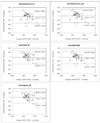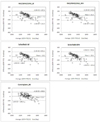1. Bland JM, Altman DG. Statistical methods for assessing agreement between two methods of clinical measurement. Lancet. 1986; 1(8476):307–310.
2. Bleiberg FM, Brun TA, Goihman S, Gouba E. Duration of activities and energy expenditure of female farmers in dry and rainy seasons in Upper-Volta. Br J Nutr. 1980; 43(1):71–82.
3. Chang UJ, Lee KR. Correlation between measured resting energy expenditure and predicted basal energy expenditure in female college students. J Korean Soc Food Sci Nutr. 2005; 34(2):196–201.
4. Crouter SE, Antczak A, Hudak JR, DellaValle DM, Haas JD. Accuracy and reliability of the ParvoMedics TrueOne 2400 and MedGraphics VO2000 metabolic systems. Eur J Appl Physiol. 2006; 98(2):139–151.
5. Cunningham JJ. A reanalysis of the factors influencing basal metabolic rate in normal adults. Am J Clin Nutr. 1980; 33(11):2372–2374.
6. Daly JM, Heymsfield SB, Head CA, Harvey LP, Nixon DW, Katzeff H, Grossman GD. Human energy requirements: overestimation by widely used prediction equation. Am J Clin Nutr. 1985; 42(6):1170–1174.
7. Food and Agriculture Organization of the United Nations. World Health Organization. United Nations University. Energy and protein requirements: report of a joint FAO/WHO/UNU expert consultation. Geneva: World Health Organization;1985.
8. Garby L, Garrow JS, Jørgensen B, Lammert O, Madsen K, Sørensen P, Webster J. Relation between energy expenditure and body composition in man: specific energy expenditure in vivo of fat and fat-free tissue. Eur J Clin Nutr. 1988; 42(4):301–305.
9. Hayter JE, Henry CJ. Basal metabolic rate in human subjects migrating between tropical and temperate regions: a longitudinal study and review of previous work. Eur J Clin Nutr. 1993; 47(10):724–734.
10. Hayter JE, Henry CJ. A re-examination of basal metabolic rate predictive equations: the importance of geographic origin of subjects in sample selection. Eur J Clin Nutr. 1994; 48(10):702–707.
11. Henry CJ. Basal metabolic rate studies in humans: measurement and development of new equations. Public Health Nutr. 2005; 8(7A):1133–1152.
12. Kim EK, Kim GS, Park JS. Comparison of activity factor, predicted resting metabolic rate, and intakes of energy and nutrients between athletic and non-athletic high school students. J Korean Diet Assoc. 2009; 15(1):52–68.
13. Kim EK, Lee SH, Ko SY, Yeon SE, Choe JS. Assessment of physical activity level of Korean farmers to establish estimated energy requirements during busy farming season. Korean J Community Nutr. 2011; 16(6):751–761.
14. Kim HR. The relationship of socioeconomic position and health behaviors with morbidity in Seoul, Korea. Health Soc Welf Rev. 2005; 25(2):3–35.
15. Lee GH, Kim MH, Kim EK. Accuracy of predictive equations for resting metabolic rate in Korean college students. Korean J Community Nutr. 2009; 14(4):462–473.
16. Lee HC. Estimating optimum level of population in rural areas based on rural population forecasts and over-depopulation classification schemes. J Rural Tour. 2007; 14(1):159–181.
17. Lee JS, Lee GH, Kim EK. Comparison of measured and predicted resting metabolic rate of 30-40 aged Korean women. J Korean Diet Assoc. 2007; 13(2):157–168.
18. Lee SH, Yeon SE, Son HR, Choi JS, Kim EK. Assessment of energy intake and physical activity level for Korean farmers to establish estimated energy requirements during the off-season for farmers. Korean J Community Nutr. 2012; 17(5):652–663.
19. Yim KS. Energy metabolism in obesity. J Korean Soc Study Obes. 2001; 10(3):271–282.
20. Liu HY, Lu YF, Chen WJ. Predictive equations for basal metabolic rate in Chinese adults: a cross-validation study. J Am Diet Assoc. 1995; 95(12):1403–1408.
21. Lührmann PM, Herbert BM, Krems C, Neuhäuser-Berthold M. A new equation especially developed for predicting resting metabolic rate in the elderly for easy use in practice. Eur J Nutr. 2002; 41(3):108–113.
22. Mifflin MD, St Jeor ST, Hill LA, Scott BJ, Daugherty SA, Koh YO. A new predictive equation for resting energy expenditure in healthy individuals. Am J Clin Nutr. 1990; 51(2):241–247.
23. Miller AT Jr, Blyth CS. Lean body mass as a metabolic reference standard. J Appl Physiol. 1953; 5(7):311–316.
24. Owen OE, Holup JL, D'Alessio DA, Craig ES, Polansky M, Smalley KJ, Kavle EC, Bushman MC, Owen LR, Mozzoli MA, Kendrick ZV, Boden GH. A reappraisal of the caloric requirements of men. Am J Clin Nutr. 1987; 46(6):875–885.
25. Owen OE, Kavle E, Owen RS, Polansky M, Caprio S, Mozzoli MA, Kendrick ZV, Bushman MC, Boden G. A reappraisal of caloric requirements in healthy women. Am J Clin Nutr. 1986; 44(1):1–19.
26. Park JA, Kim KJ, Kim JH, Park YS, Koo J, Yoon JS. A comparison of the resting energy expenditure of Korean adults using indirect calorimetry. Korean J Community Nutr. 2003; 8(6):993–1000.
27. Park J, Kazuko IT, Kim E, Kim J, Yoon J. Estimating freeliving human energy expenditure: practical aspects of the doubly labeled water method and its applications. Nutr Res Pract. 2014; 8(3):241–248.
28. Schofield WN, Schofield C, James WP. Basal metabolic rate: review and prediction, together with an annotated bibliography of source material. Hum Nutr Clin Nutr. 1985; 39C:suppl. 1. 5–96.
29. Singh J, Prentice AM, Diaz E, Coward WA, Ashford J, Sawyer M, Whitehead RG. Energy expenditure of Gambian women during peak agricultural activity measured by the doubly-labelled water method. Br J Nutr. 1989; 62(2):315–329.
30. Suh MK. Health states of the elderly and policy implications. J Korea Gerontol Soc. 1995; 15(1):28–39.
31. Taaffe DR, Thompson J, Butterfield G, Marcus R. Accuracy of equations to predict basal metabolic rate in older women. J Am Diet Assoc. 1995; 95(12):1387–1392.
32. The Korean Nutrition Society. Dietary reference intakes for Koreans. Seoul: The Korean Nutrition Society;2005.
33. The Korean Nutrition Society. Dietary reference intakes for Koreans. Seoul: The Korean Nutrition Society;2010.
34. Tzankoff SP, Norris AH. Effect of muscle mass decrease on age-related BMR changes. J Appl Physiol Respir Environ Exerc Physiol. 1977; 43(6):1001–1006.
35. Tzankoff SP, Norris AH. Longitudinal changes in basal metabolism in man. J Appl Physiol Respir Environ Exerc Physiol. 1978; 45(4):536–539.
36. Weir JB. New methods for calculating metabolic rate with special reference to protein metabolism. 1949. Nutrition. 1990; 6(3):213–221.
37. World Health Organization. Obesity: preventing and managing the global epidemic. Report of a WHO Consultation. Geneva: World Health Organization;2000.
38. Yamauchi T, Ohtsuka R. Basal metabolic rate and energy costs at rest and during exercise in rural- and urban-dwelling Papua New Guinea highlanders. Eur J Clin Nutr. 2000; 54(6):494–499.
39. Yeon SE, Son HR, Choi JS, Kim EK. Relationships among serum adiponectin, leptin and vitamin D concentrations and the metabolic syndrome in farmers. Korean J Community Nutr. 2014; 19(1):12–26.











 PDF
PDF ePub
ePub Citation
Citation Print
Print





 XML Download
XML Download